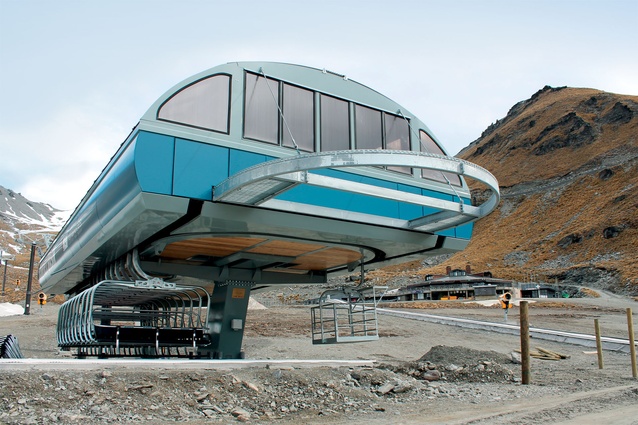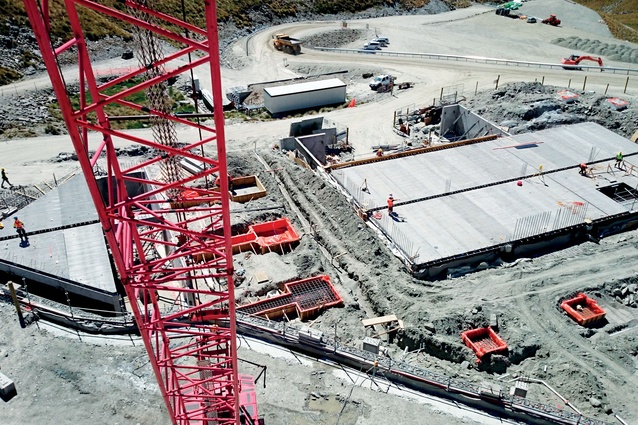Base build
Working 1,600 metres above sea level to construct a 6,019m2 building at the base of a skifield – a site only accessible by a winding, mostly unsealed mountain road – posed significant challenges for the construction team.
Starting in late September 2014 at the end of the ski season, the construction team led by Arrow International’s southern director Nick Hamlin, faced everything from blizzard conditions and temperatures that plummeted below zero to searing heat on summer days.
The building, which will be finished for the 20 June start of the 2015 ski season at The Remarkables, will function as the resort’s new base building. Designed to accommodate 3,500 guests per day, it will house guest services, the snowsport school, retail tenancies, rental equipment and guest toilets on the ground floor. An extensive restaurant and cafe will take up level one, with a 10-metre-high glass frontage to the ski area that provides guests with extensive views of the ski area terrain and lifts.
Wrap-around decks open up to the ski area, provide seating for 500 people (additional to the 700 seats inside), and offer views across the Wakatipu Basin on the opposite side.
NZ Ski chief executive Paul Anderson says the $20 million project is part of a $45 million upgrade to The Remarkables, which includes a new six-seat chairlift, upgraded snowmaking facilities, extended and new trails, extra carparking and road improvements.
“This is the most substantial ski area investment made in the Southern Lakes area since the base building upgrade at Coronet Peak in 2007,” Anderson says. “Overall, the upgrade increases the capacity of the ski area by 40 per cent, from 2,500 to 3,500 skiers per day.”
Last year marked the beginning of the extensive project, with the creation of new skiable terrain: earthworks were completed in the summer of 2014 in which around 200,000m3 of earth was moved to create the trails – enough to fill 1,000 Olympic-sized swimming pools.
Snowmaking capacity was also more than doubled during the 2014 summer months with the installation of 48 new snowguns and related infrastructure. “This gives us the capacity to create 240 litres of snow per second. That’s enough to fill 10 Olympic-sized swimming pools in 24 hours,” Anderson says.
But it is this summer that work got underway in earnest on the new base building after the design phase commenced about 18 months ago.
The three-storey building is located at the bottom of the learners’ slopes, with the ground floor essentially at ‘street level’ in that buses will pull up to this level; inside is ticketing, rental equipment, related retail tenancies and administration areas.
Below, in the basement, snow making facilities are housed along with all the services. And on level one, guests can walk straight out onto the snow from the large deck area.
Construction will be complete in just eight months – a feat in the alpine environment.
“We had to really think about different ways we could build this building quickly but safely,” Arrow’s southern director Nick Hamlin says. “It’s basically a big Meccano set.”
The basement and ground floor levels are pre-cast concrete – walls, panels, columns and beams and double-T pre-cast flooring.
The first floor is a steel structure with the tubular steel a striking feature of the finished building.
“We will put the steel structure together on the adjacent learners’ slopes and then crane it into place,” Hamlin said.
The façade is a mix of glazing to take in the views, and an insulated Kingspan panel product.
As can be typical, when the fields shut at the end of the 2014 season and the construction crew got into full swing, the snow didn’t stop. In fact, for the first six weeks on site, it snowed about half the time.
In mid-January, 130m3 of concrete was poured: starting at 4am, the pour wasn’t finished until 4pm the same day due to the time it took for trucks to access the site.
Another challenge for the project team was water entering the site as a result of snow melting. Hamlin says a system was devised to pump it away from the site, and extensive permanent drainage channels ensure this is not a continuing issue for the completed building.
The fate of the former base building, which was built in the 1980s, is yet to be known. Anderson says the way mountain guests utilise the old building in the 2015 snow season will provide NZ Ski with better understanding of its potential, and a plan will be made subsequently.
The timing of the improvements is apt. This is The Remarkables’ 30th year. Opening in 1985, it is one of the country’s most popular ski resorts. “The improvements will enhance The Remarkables’ reputation as one of the best places to ski or snowboard for both our local and overseas guests,” Anderson says.














